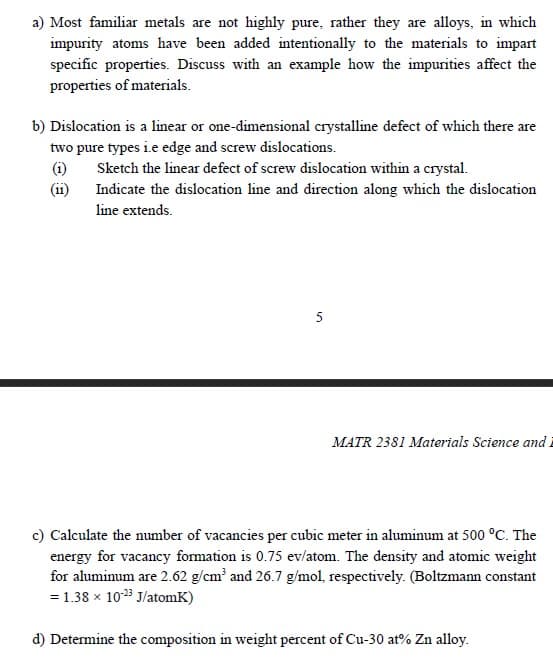a) Most familiar metals are not highly pure, rather they are alloys, in which impurity atoms have been added intentionally to the materials to impart specific properties. Discuss with an example how the impurities affect the properties of materials.
a) Most familiar metals are not highly pure, rather they are alloys, in which impurity atoms have been added intentionally to the materials to impart specific properties. Discuss with an example how the impurities affect the properties of materials.
Elements Of Electromagnetics
7th Edition
ISBN:9780190698614
Author:Sadiku, Matthew N. O.
Publisher:Sadiku, Matthew N. O.
ChapterMA: Math Assessment
Section: Chapter Questions
Problem 1.1MA
Related questions
Question

Transcribed Image Text:a) Most familiar metals are not highly pure, rather they are alloys, in which
impurity atoms have been added intentionally to the materials to impart
specific properties. Discuss with an example how the impurities affect the
properties of materials.
b) Dislocation is a linear or one-dimensional crystalline defect of which there are
two pure types i.e edge and screw dislocations.
(i)
(ii)
Sketch the linear defect of screw dislocation within a crystal.
Indicate the dislocation line and direction along which the dislocation
line extends.
5
MATR 2381 Materials Science and.
c) Calculate the number of vacancies per cubic meter in aluminum at 500 °C. The
energy for vacancy formation is 0.75 ev/atom. The density and atomic weight
for aluminum are 2.62 g/cm? and 26.7 g/mol, respectively. (Boltzmann constant
= 1.38 x 1023 J/atomK)
d) Determine the composition in weight percent of Cu-30 at% Zn alloy.
Expert Solution
This question has been solved!
Explore an expertly crafted, step-by-step solution for a thorough understanding of key concepts.
Step by step
Solved in 2 steps

Knowledge Booster
Learn more about
Need a deep-dive on the concept behind this application? Look no further. Learn more about this topic, mechanical-engineering and related others by exploring similar questions and additional content below.Recommended textbooks for you

Elements Of Electromagnetics
Mechanical Engineering
ISBN:
9780190698614
Author:
Sadiku, Matthew N. O.
Publisher:
Oxford University Press

Mechanics of Materials (10th Edition)
Mechanical Engineering
ISBN:
9780134319650
Author:
Russell C. Hibbeler
Publisher:
PEARSON

Thermodynamics: An Engineering Approach
Mechanical Engineering
ISBN:
9781259822674
Author:
Yunus A. Cengel Dr., Michael A. Boles
Publisher:
McGraw-Hill Education

Elements Of Electromagnetics
Mechanical Engineering
ISBN:
9780190698614
Author:
Sadiku, Matthew N. O.
Publisher:
Oxford University Press

Mechanics of Materials (10th Edition)
Mechanical Engineering
ISBN:
9780134319650
Author:
Russell C. Hibbeler
Publisher:
PEARSON

Thermodynamics: An Engineering Approach
Mechanical Engineering
ISBN:
9781259822674
Author:
Yunus A. Cengel Dr., Michael A. Boles
Publisher:
McGraw-Hill Education

Control Systems Engineering
Mechanical Engineering
ISBN:
9781118170519
Author:
Norman S. Nise
Publisher:
WILEY

Mechanics of Materials (MindTap Course List)
Mechanical Engineering
ISBN:
9781337093347
Author:
Barry J. Goodno, James M. Gere
Publisher:
Cengage Learning

Engineering Mechanics: Statics
Mechanical Engineering
ISBN:
9781118807330
Author:
James L. Meriam, L. G. Kraige, J. N. Bolton
Publisher:
WILEY